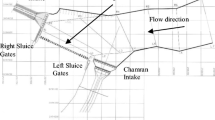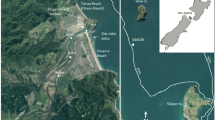Abstract
The main objective of this paper is to develop a method to simulate long-term morphodynamics of estuaries dominated by fine sediments, which are subject to both tidal flow and meteorologically induced variations in freshwater run-off and wave conditions. The method is tested on the Vilaine Estuary located in South Brittany, France. The estuary is subject to a meso–macrotidal regime. The semi-diurnal tidal range varies from around 2.5 to 5 m at neap and spring, respectively. The freshwater input is controlled by a dam located approximately 8 km from the mouth of the estuary. Sediments are characterised as mostly fines, but more sandy areas are also found. The morphology of the estuary is highly influenced by the dam. It is very dynamic and changes in a complicated manner with the run-off from the dam, the tide and the wave forcing at the mouth of the estuary. Extensive hydrodynamic and sediment field data have been collected in the past and provide a solid scientific basis for studying the estuary. Based on a conceptual understanding of the morphodynamics, a numerical morphological model with coupled hydrodynamic, surface wave and sediment transport models is formulated. The numerical models are calibrated to reproduce sediment concentrations, tidal flat altimetry and overall sediment fluxes. Scaling factors are applied to a reference year to form quasi-realistic hydrodynamic forcing and river run-off, which allow for the simulations to be extended to other years. The simulation results are compared with observed bathymetric changes in the estuary during the period 1998–2005. The models and scaling factors are applied to predict the morphological development over a time scale of up to 10 years. The influence of the initial conditions and the sequence of external hydrodynamic forcing, with respect to the morphodynamic response of the estuary, are discussed.


















Similar content being viewed by others
References
DHI (2009a) MIKE 21 & MIKE 3. Flow model FM hydrodynamic and transport module scientific documentation. DHI, Hørsholm, 50 p. Accessed March 2009
DHI (2009b). Modélisation numérique hydrosédimentaire de l’estuaire de la Vilaine. Phase 4 : Modélisation hydrodynamique. Report prepared for IAV. http://www.eptb-vilaine.fr/site/index.php/lestuaire/etudes-et-rapports/etudes. Accessed March 2009
Fredsoe J (1984) Turbulent boundary layer in a wave–current motion. J Hydraulic Engng 110:1103–1120, ASCE
Goubert E, Menier D (2005) Evolution morphosédimentologique de l’estuaire de la Vilaine de 1960 à 2003: valorisation des campagnes bathymétriques. Report prepared by UBS for IAV, 104 pp. http://www.eptb-vilaine.fr/site/index.php/lestuaire/etudes-et-rapports/etudes. Accessed November 2005
Goubert E, Frenod E, Peeters P, Thuillier P, Vested HJ, Bernard N (2010) The use of altimetric data (Altus) in the characterization of hydrodynamic climates controlling hydrosedimentary processes of intertidal mudflat: the Vilaine estuary case (Brittany, France). Revue Paralia 3:6.17–6.32
Hibma A (2004) Morphodynamic modelling of estuarine channel–shoal systems. PhD thesis, Delft University of Technology, pp 143
Jestin H, Bassoullet P, Le Hir P, L'Yavanc J, Degres Y (1998) Development of ALTUS, a high frequency acoustic submersible recording altimeter to accurately monitor bed elevation and quantify deposition or erosion of sediments, vol. 1. OCEANS '98 Conference Proceedings. pp 189–194
Latteux B (1995) Techniques for long-term morphological simulations under tidal action. Mar Geol 126:129–141
Le Hir P, Cayocca F, Waeles B (2011) Dynamics of sand and mud mixtures: a multiprocess-based modelling strategy. Cont Shelf Res 31:135–149
Lumborg U, Pejrup M (2005) Modelling of cohesive sediment transport in a tidal lagoon—an annual budget. Mar Geol 218:1–16
Mitchener HJ, Torfs H, Whitehouse RJS (1996) Erosion of mud/sand mixtures. Coast Eng 29:1–25, Errata 1997, 30, 319
Petersen O. and Vested HJ (2002) Description of vertical exchange processes in numerical mud transport modelling. In: Winterwerp C and Kranenburg C (eds) Fine sediment dynamics in the marine environment. Elsevier, Amsterdam, pp 375–393
Roelvink D, Reniers A (2012) A guide to modelling coastal morphology. Advances in coastal and ocean engineering, vol. 12. World Scientific Publishing Co. Singapore, pp 292
Sørensen OR, Kofoed-Hansen H, Rugbjerg M and Sørensen LS. (2004) A third-generation spectral wave model using unstructured finite volume technique. Proceedings of the 29th International Conference on Coastal Engineering. World Scientific, 894–906
Soulsby RL, Hamm L, Klopman G, Myrhaug D, Simons RR, Thomas GP (1993) Wave–current interaction within and outside the bottom boundary layer. Coastal Enggr 21:41–69
Teeter AM (1986) Vertical transport in fine-grained suspension and nearly deposited sediment. Estuarine cohesive sediment dynamics, lecture notes on coastal and estuarine studies, 14, Springer, Berlin, pp 126–149
Teisson C (1991) Cohesive suspended sediment transport: feasibility and limitations of numerical modelling. J Hydraul Res 29(6):755–769
Tessier C, Le Hir P, Dumas F, Jourdin F (2008) Modélisation des turbidités en Bretagne Sud et validation par des mesures in-situ. European Journal of Environmental and Civil Engineering 12(1–2):179–190
Tessier C, Vested HJ, Christensen BB, Goubert E and Salaün F (2012) Modélisation numérique de la dynamique sédimentaire de l’estuaire de la Vilaine. XIIièmes Journées Nationales Génie Côtier -Génie Civil, Cherbourg, 12–14 juin, Actes de colloques, Editions Paralia CFL, pp.471-480, doi:10.5150/jngcgc.2012.051-T
Toorman EA, Bruens AW, Kranenburg C and Winterwerp JC (2002) Interaction of suspended cohesive sediment and turbulence. In: Winterwerp JC and Kranenburg C (eds) Fine sediment dynamics in the marine environment. Elsevier, Amsterdam, pp 7–23
van Ledden M, Wang ZB, Winterwerp H, de Vriend H (2006) Modelling sand–mud morphodynamics in the Friesche Zeegat. Ocean Dyn 56:248–265
Waeles B (2005) Modelisation morphodynamique de l’embouchure de la Seine. PhD Thesis, IFREMER/Université de Caen, France, pp 230
Whitehouse R, Soulsby R, Roberts W and Mitchener H (2000) Dynamics of estuarine muds HR Wallingford & Thomas Telford, London
Winterwerp JC and Kesteren WMG (2004) Introduction to the physiscs of cohesive sediment in the marine environment. Elsevier, Amsterdam
Acknowledgments
The authors acknowledge the support by IAV and their special advisor Bernard Latteux. The study has benefitted from his inspiring input and review of reports. The authors also appreciate discussions with Pierre le Hir. The work required changes to standard DHI software. Bed masses, for each fraction in each layer from the previous simulation year, can now be applied as initial conditions for the next year. The settling velocity formulation was modified to have one fraction with, and one fraction without flocculation. These changes were implemented with the help of Ole Petersen, DHI. The paper has greatly benefitted from comments by the two anonymous reviewers and the editor Han Winterwerp. This work has been partly supported by the Danish Council for Strategic Research (DSF) under the project: Danish Coasts and Climate Adaptation – Flooding risk and coastal protection (COADAPT), project no. 09-066869.
Author information
Authors and Affiliations
Corresponding author
Additional information
Responsible Editor: Han Winterwerp
This article is part of the Topical Collection on the 11th International Conference on Cohesive Sediment Transport
Rights and permissions
About this article
Cite this article
Vested, H.J., Tessier, C., Christensen, B.B. et al. Numerical modelling of morphodynamics—Vilaine Estuary. Ocean Dynamics 63, 423–446 (2013). https://doi.org/10.1007/s10236-013-0603-7
Received:
Accepted:
Published:
Issue Date:
DOI: https://doi.org/10.1007/s10236-013-0603-7




